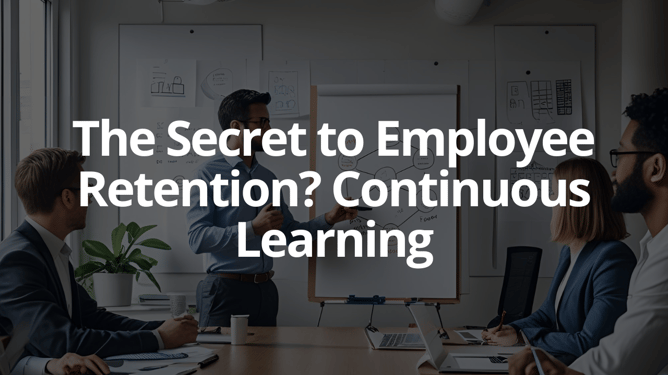How To Create A Highly Effective Learning And Development Plan

Let’s clarify something. This blog is for creating exceptional learning plans.
So, as you can imagine, we are going to be covering a lot of important ground today. Ground so important, that we have put together an agenda of what we will be guiding you through.
How formal!
What you will learn from this blog:
- What is a Learning and Development Plan?
- Do I Need a Learning and Development Plan?
- What do I Need to Include in a Learning and Development Plan?
- What are the Key Elements of a Learning and Development Plan?
- How do I Implement my New Learning Plan?
This information has the potential to make such an impact on you, your team, your department, and your organisation, that I do not want to make this introduction any longer… let’s end the anticipation and get into it!
-
What Is A Learning And Development Plan?
Good question… and a very good place to start!
Simply put, a learning and development plan is your proposal of action as to how you will approach people development so that you achieve your business goals. It’s where people and business come together.
An L&D plan outlines and describes the following:
- Why is learning and development required, what are the business goals you need to deliver?
- Who requires development?
- What development do they need?
- When will the development need to take place?
- How will the training and learning be delivered?
- Where will it take place?
When complete, your L&D plan is your roadmap from where you find yourself, team, and business now to where you desire to be at the conclusion of the timescale you have set out.
This is your overall aim, but there are plenty of other crucial things that your plan will also achieve along the way. These include developing a talent pipeline that will continue to deliver on goals, employee satisfaction and succession planning.
Powerful stuff!
………………………….
Pressed for time? With this blog being jam packed with learning planning information, you may feel as though you are not sure where to begin when it comes to designing yours.
Therefore, we have created a learning plan checklist. This checklist contains areas to consider when planning that, once you have the confidence to tick off, you will know that you have the foundations of a highly effective and impactful learning plan.
………………………….
-
Do I Need A Learning And Development Plan?
I could and should answer this in a single three letter word.
But I suppose, the answer is no… you do not need a learning and development plan.
However, if you are leaning towards not having a plan, then you are accepting risks that having an L&D plan counteract.
It may somehow all work out for you, but it could also end up having a catastrophic impact on your people, team, and business.
Having an L&D plan protects you from this.
You are hugely reducing the risk of your business being caught out and needing to react when, and if, performance falters.
Setting out a plan designed to tackle potential problems is challenging, however it is much easier than trying to resolve an issue after it has occurred.
By forward planning, you are giving yourself the time to consider the resources you have at your disposal to ensure you achieve your desired goals.
To contrast, when under pressure, it becomes easier to just desperately grab at the data you have at hand, such as just a basic training needs analysis, and to not consider the bigger picture.
Imagine a Training Manager asks a Sales Manager, “What training courses does your team need?”.
Without a plan, the Sales Manager collates some ideas from the team and says “We need presentation skills training and some training on how to be better at closing.”
Seems quite sporadic and spur of the moment, rather than organised, and well-prepared.
It runs the risk of missing the true needs of the whole team, and instead just addressing what seems to be the issue on the surface. It also is in danger of being focused on the present and the past with no reference to future needs of the business or trends in society/technology.
For example, in preparation for the training plan, this Sales Manager could have analysed data from the past year, broken down performance rates at every step of the sales cycle, and held multiple conversations to discuss obstacles felt within the team to be more able to target the exact remedy.
Additionally, when given the time to analyse, greater thought can be given to the outcomes that any training could have, rather than just surface level process-based solutions.
-
What Do I Need To Include In A Learning And Development Plan?
It is incredibly difficult to give you the answer to this question in one definitive solution as there are so many variables at play. The crucial element to a successful training plan is how it truly fits into the context that it has been created for.
The last thing we would want is for you to leave this blog with the ability to create a highly detailed, but potentially wide-of-the-mark L&D plan.
To avoid this happening, we have a framework which has been tried and tested in a diverse range of industries including media, healthcare, and e-commerce, which will ensure that each element within your plan will support your people, teams, and business to achieve their performance goals.
Now let’s get started!
-
What Are The Key Elements Of A Learning And Development Plan?
Business Goals
It really is surprising how many articles and resources exist out there, with the same purpose as this one, but which make no reference to future performance and deliverables when building learning plans.
Instead, mainly focusing on just today’s ‘learning needs’ ’.
If you are to have high confidence in the learning plan that you create, it must be built around the business vision, and the goals that you want to achieve.
In a sense, you are reverse engineering.
You are plotting out how your people, teams and business is going to look in the future and working backwards from that point to establish the capabilities you will need to develop, to realise the vision.
You need to define what good is.
Then work to decide how good you are already and how you can become better.

Current Performance
“Why should I waste time thinking about what we are already good at, when I should be focusing on what we need to work on?”
Whilst it is crucial to identify which knowledge, skills, and attitude gaps you will be looking to fill, there are also several important reasons why you should establish current performance first.
First off, it is vital in tracking the progress of people, teams, and business as a whole system, as your learning plan is rolled out. It is also important to the motivation of individuals to know that they are continuing to meet or exceed the standards required. Additionally, as your plan transitions into action, you will still want to maintain and reinforce these existing strengths whilst developing in other areas.
A great place to start with this is to answer the question… What are you already doing well to deliver your business’ goals?
By investing time to research this across a variety of stakeholders, you will gain greater insight as to what is working and contributing towards current performance.
This then sets us up perfectly to work out what is missing.
Gap Analysis
Time for another example!
You may discover when looking for development areas to bring into your plan, that members of your sales team, whilst good at presenting data, are not currently showcasing abilities to connect, build rapport and have meaningful conversations with their audience.
Now, the question we have to answer is… what gap do we need to close so we can deliver that business goal?
We completely recognise that this is a huge question… one with a whole host of potential answers.
Therefore, we have three break-off questions that will help guide you towards your answer.
- Firstly, are there any areas of knowledge that are missing completely or are below where you need them to be?
- Secondly, are there any skill areas that are missing completely or are less than you desire?
- Finally, are there any changes or improvements to attitude and mindset that would make an impact?
So, before these questions, we were exploring the example of a sales team lacking the ability to build rapport and connections with the people that they are presenting to.
Now, based off that observation, you could just say that they clearly need some form of communication training to close that gap and get them performing at the desired level.
However, is there anything else that could be much more impactful?
Is there potentially a key knowledge gap which is causing the team to focus more on their input, rather than interacting with their audience?
Could it also be that they simply do not know enough about the customer, their needs, and expectations?
With regard to skills, what could this team need to develop to open up these conversations? Potentially, it could be some form of social skills development. However, it could also be that, whilst they can build rapport 1-on-1, they struggle in group discussions and presentations.
Finally, could the gap potentially exist within the attitude of the team.
Are they battling with self-confidence and self-belief? Do they not value the importance of building good connections with potential clients?
Suddenly, we have multiple development areas to explore. However, with these now on your radar, once identified, we can be sure that the training you include in your plan is much more likely to have the desired effect and it will have much more specific outcomes.
Your Resources
Would you plan what you are going to cook for dinner without looking at what you have in your fridge, cupboards, freezer etc?
It is highly unlikely.
Unless you are some kind of maverick unorthodox chef who could make a Spaghetti Bolognese out of half a bottle of milk, a satsuma and three tins of tuna.
Otherwise, it is always a good idea to take stock of what you have available to you before you decide how you can bring it all together in order to create something magnificent.
Magnificent in the sense that it delivers the impact you desire and also in that it provides a maximum return on investment and proves great value.
It’s exactly the same with Learning and Development. Consider the resources available to you in the sense of time, budgets and materials, so you can ensure your plan is realistic and will give you the magnificence your teams deserve.
How Can I Deliver Knowledge?
Since 2020, there has been a noticeable shift in preference as to how businesses develop the knowledge of their people.
Before this, it was more likely that when planning a solution to close a knowledge gap that it would become an in-person, classroom style experience. With people needing to travel and be on location in order to be a part of it.
There are a few reasons as to why this school of thought was incredibly popular.
One main pull for these types of experiences though was that the impact of any session could be maximised by the energy, attentiveness, and intimacy that an in-person learning experience can provide.
Things have shifted since the pandemic though.
Due to Covid lockdowns and restrictions, we were all forced into relying on communication platforms and technology that existed long before any global crisis.
The pandemic gave us the enforced experience to learn how to best utilise each available virtual resource to become a valuable learning platform. Whereas before, it didn’t matter so much. We had proven alternatives.
Now, live virtual sessions are seen to be a genuine alternative to face-to-face sessions, without seeming like you are compromising on learning impact.
Remotely delivered learning is also a way of saving that large portion of your historical training budget that was spent on travel, hotels, room hires etc. There is also less time spent out of office as a consequence.
In addition to this, virtual learning promotes bite sized sessions in a series which helps with continuity and embedding as learners can implement their new found competence and confidence straight away.
When mapping this out, it is important to establish the learning preferences of participants. This could be important when considering things such as the types of learning experiences you will introduce, the times that they will be running and the styles of facilitators.
Blended learning journeys are a fantastic way of diversifying your experiences so that they can appeal to the learning preferences of the various participants.
This could mean that you look at building a programme which includes in-person and virtual sessions, as well as:
- Coaching
- Webinars
- E-learning modules
- Ongoing programme-relevant projects
How Can I Develop New Skills?
Gaining knowledge is a fantastic feeling.
You feel more informed, empowered, and better equipped to tackle obstacles that previously seemed far too large to scale.
So, let’s fire up another example.
You have recognised that your managers would benefit from learning some coaching skills.
Now of course, they could read books, listen to podcasts, and perhaps even read a highly informative blog or two on the Excel website to gain vital knowledge. As we live in the age of information, where you can find the answers to most things with a simple click on Google, it’s more important than ever that we recognise that knowing is not the same as doing. We want to develop actual skills that we can apply to our lives.
That’s where your learning experiences come in.
They can provide the environment for participants to take in the theory, but then also award them with the platform to develop specific skills, live. For our coaching example, this could be skills such as active listening and impactful questioning.
There are so many treasures to be found in live learning experiences, whether in-person or online, when it comes to quickly learning new skills. They are an opportunity for participants to ask specific questions on the topic to an expert trainer, to demonstrate the knowledge they have learned with other learners, and to receive instant, specific feedback on their skills which gives them clear advice on how to develop further.
Live sessions achieve this in a way that other passive methods struggle to; methods such as on-demand modules, webinars, or live seminars with huge numbers of attendees. Which is why we tend to view these other types of learning experiences as supplements to live, interactive sessions.
They are capable of adding to the pillar sessions of a programme, but they do not always have an impact when consumed alone.
Another treasure that exists within live sessions is the facilitator.
Heading back to our coaching example. If your participants are being shown key coaching knowledge and skills by an experienced, expert trainer, they are highly likely to see them role modelled and demonstrated clearly throughout.
An experienced trainer also knows when to train, when to coach and when to let people try, even if it means they fail, in order to get the insight and the inspiration to then succeed.
Online e-learning alone, on the other hand, will not bring about behavioural, capability or belief level change that is sustainable.
This is unlike a live training event, which enables participants to experience learning from 3 perspectives.
- First Position – They learn from trying the skills, such as coaching, and find out what it is like to be a coach.
- Second Position – In terms of coaching, they would experience insights and learnings as they are coached by their colleagues during exercises – they become the coachee.
- Third Position – Participants have the opportunity to observe colleagues during exercises and observe how different coaching styles impact the person being coached, including their level of motivation and the results that are achieved.

How Can I Adjust Attitudes?
At some point, you may have heard someone suggest that someone needs to ‘change their attitude’.
Sounds quite straight forward, doesn’t it?
However, the vagueness of just asking someone to ‘change their attitude’ is not actually very helpful at all.
Let’s say for example that you have a member of your team that shows little interest in training and personal development.
Would saying “you need to change your attitude” actually help have an immediate response on this individual? Not only that, will it help to adjust things in the long-term?
What would be much more helpful is to set in place some appropriate interventions to help understand and influence what is the cause of this person’s current attitude.
For example, you could be determining the cause of the current attitude of a salesperson who is underperforming.
You may hear the following:
- “I am not sure this is the right place for me any longer”
This suggests that they feel a disconnect between themselves and the company, whether that be their team or the company culture.
Once you discover what the disconnect is, you can then begin exploring how you can address it.
- “You tell me about how I should close on a sales call but never show me how”
This suggests that the person’s attitude could be due to not feeling fully equipped to fulfil their role and to succeed.
Live sessions and coaching can rectify this.
- “That style of close does not work for me, so I am not using it”.
This shows that they lack belief in the information and guidance that they have been given. This however is an opinion, as if they have never fully believed in it and used it with confidence, we simply do not know whether it won’t work for them.
Coaching and discussion, related to what they can and can’t do in terms of closes, will support them.
- “I am bad at negotiating, so why am I doing it? Let someone better do it.”
In this situation, this person does not identify with being good in negotiation. Which suggests that they could use specific development in that area, or even addressing their issues of self-confidence.
This kind of statement indicates that this person may currently have a fixed mindset, where they believe they either can or they can’t. Helping this person to transition to a growth mindset, where they know that they can always learn how to do something better, could lead them being less disheartened and dismissive at performing this part of their role.
It is not uncommon for a person to be written off by a manager or a company because of their attitude, instead of it being addressed. By dismissing them, it is wasting the talents they do hold, as they are finding it hard to overcome an issue.
Supporting an individual to discover what is at the root of a perceived ‘attitude problem’ and working with them to make the changes they need to improve performance, is mutually beneficial.
Some employers do not even write off people who seem to have ‘the wrong attitude’, instead deciding to ignore it all together despite having the resource and support in place to help.
Often overlooked in training plans is the recruitment of new talent and the retention of existing talent.
Recruiting people that demonstrate the attitude that you know will deliver your business goals is much more favourable than just basing the decision on skills and knowledge.
Attitude is much more innate than skills.
This means that ‘competency-based interviewing’ and ‘how to spot and retain talent’ become key components of training that is required for your managers.
-
How Do I Implement My New Learning Plan?
This part really does not need to be complicated.
It should be a simple process that can be applied to individuals, teams, departments or to the company as a whole. You can build it any which way. Bottom up or top down.
When it comes to implementation, there are two stages of questions to answer to then find the clearest action plan for you.
The first set are mainly centred around strategic thinking.
These include:
- What training is required that will support the achievement of the business goals?
- Why is it required? This is important so that all stakeholders understand the purpose of the training.
- Who requires what training and, critically, who will deliver it?
Once we have determined answers to this set, we can then look at the logistics.
These questions include:
- How will the training be delivered?
- Where will it take place?
- When will it take place?
Also, crucial when it comes to implementing a plan, is that you have set out time to assess the plan when active and also that you are measuring the impact of each step.
This could be quarterly reviews as a minimum to check progress and adjust the plan to assess, and identifying specific behavioural outcomes, taking a baseline measurement before enacting the plan, and then evaluating after learning events to see the impact of each.
Summary
And there you have it! Your guide to building a highly effective L&D plan!
However, whilst we have now reached the end of this blog, we are far from at the conclusion for all the ways in which Excel can help you to develop yourself, others and achieve the success you crave by creating long lasting behavioural changes.
Beyond all of the learning content and resources available here on our website, we also have a super-friendly team of learning experts that are excited and equipped to support you with any personal development questions, ideas, or projects that you have.
Come talk to us over on our contact page.
You will also be blown away by how quickly we respond. We just love virtual coffees and development discussions.
Do you know we also make video summaries of our blogs? Watch here:
Thanks!
Alex & The Excel Team

P.S. If you would like to discuss any of your learning & development challenges for 2022, call us on +44(0) 1628488 854.
About Excel Communications
Excel Communications is a learning and development consultancy based near London in the U.K. For more than 30 years; we have been collaborating with clients across the globe. Partnering with Excel empowers you to evolve your people and business by fuelling a love for learning. We work with you to create unforgettably, customised learning experiences to achieve your vision of success and growth, with tangible results. View our case studies here. We have a team of expert trainers delivering programmes across five continents in multiple languages. Call us now on +44 (0) 1628 488 854.
Important
If you would like to watch our leadership masterclass recordings, you can access the latest leadership complimentary guide here.






